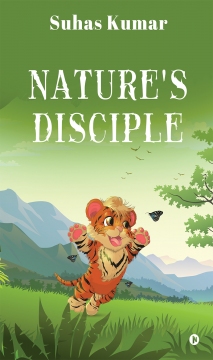
- Discover books
- For Writers
-
For Writers
-
Indie Author Championship
-
Challenges
Writing Contests
- Get Started

"It was a wonderful experience interacting with you and appreciate the way you have planned and executed the whole publication process within the agreed timelines.”
Subrat SaurabhAuthor of Kuch Woh Pal -
-
-
IN
- India
- Singapore
- Malaysia
- 0
Suhas Kumar
Speaker and WriterSuhas Kumar retired as the Principal Chief Conservator of Forests from the Madhya Pradesh Forest Department. Out of his 35 years in the Indian Forest Service, he spent 23 years managing, supervising, and guiding the management and training the officers and staff of national parks, sanctuaries, and tiger reserves of the state. He was the Director of Pench National Park (now a tiger reserve) for almost five and a half years (April 1985 to August 1990) during its formative period. He headed the Wildlife Extension Faculty at Wildlife Institute of India, Dehradun, from December 1990 to April 1996 aRead More...
Suhas Kumar retired as the Principal Chief Conservator of Forests from the Madhya Pradesh Forest Department. Out of his 35 years in the Indian Forest Service, he spent 23 years managing, supervising, and guiding the management and training the officers and staff of national parks, sanctuaries, and tiger reserves of the state. He was the Director of Pench National Park (now a tiger reserve) for almost five and a half years (April 1985 to August 1990) during its formative period. He headed the Wildlife Extension Faculty at Wildlife Institute of India, Dehradun, from December 1990 to April 1996 and contributed to the growth of the training capabilities of WII. In the field, he has been an initiator of several innovative measures that have contributed immensely to strengthen the management of wildlife in Madhya Pradesh. Some of his major contributions are the establishment of regional and divisional wildlife rescue squads, tiger strike force–a trained and equipped wildlife crime control set-up, and the school of wildlife forensic and health and the first non-invasive mass capture and relocation of hard ground barasingha. He had guided the scientific management of habitats, especially grasslands, and revamped and streamlined the MP tiger foundation society and Park development fund.
Suhas is a trained wildlife manager, a law graduate, and holds a Ph.D. in Environment and Ecology discipline in the field of ecotourism in protected areas. He has also acquired some knowledge and training in nature interpretation and ecotourism from the US, the UK, and Australia. Presently, he is a member of Chhattisgarh State Board for Wildlife, WWF-India’s State Advisory Board for Madhya Pradesh and Chhattisgarh, and the Governing Body and Governing Council of National Centre for Human Settlement and Environment, Bhopal. He is also a member of the Delhi Biodiversity Society. Earlier, he had served as the chairman of the Research Advisory Committee of the M.P. State Biodiversity Development Board and member of Madhya Pradesh State Board for Wildlife for two terms. He was the chairman of one of the evaluation teams constituted by NTCA in 2017-18 for 13 tiger reserves of the country.
His write-ups, research papers, and case studies have been published in books, magazines, newspapers, and web media. Wildlife Management, Ecotourism Planning, Participatory Forest Management, Wildlife Rescue, Wildlife Health, Wildlife Crime Investigation, and Interpretation & Conservation Education have been his areas of interest, and his contribution to each of these aspects has been uniquely useful.
You may give your feedback to the Author at sukum48@rediffmail.com
Read Less...Crop your profile image

Nature’s Disciple (Black & White Edition)
Books by Suhas Kumar
This book is set in central Indian forests, largely in Madhya Pradesh—the torch bearer of wildlife management in our country—that also has relevant reference to the forests of Vidarbha region of the neighbouring Maharashtra. The book has arrived as a breath of fresh air and candour at a time when some of the wild animals, specifically the leopards and tigers, in the present context are being viewed by the ill-informed and uncaring section of the society as
This book is set in central Indian forests, largely in Madhya Pradesh—the torch bearer of wildlife management in our country—that also has relevant reference to the forests of Vidarbha region of the neighbouring Maharashtra. The book has arrived as a breath of fresh air and candour at a time when some of the wild animals, specifically the leopards and tigers, in the present context are being viewed by the ill-informed and uncaring section of the society as inimical to the lives of people. While incidents of strife are usually reported from rural India, some of the urban sprawls that fail to rein in their poorly planned expansion across the existing forested tracts on their doorstep, which has been the case of the MP state capital Bhopal, are no exception.
While painting the lives of wild creatures with delicate strokes of an artist’s brush, the pages, without breaking stride, deal with men who have wrested as large slices of the natural areas as possible from being lost to the relentless march of ‘development,’ encroachments, and other human activities. There are lessons in the highest levels of conservation leadership without hiding the soft belly of the onerous tasks.
There is narrative of large predators in trouble—leopards and tigers; of the local extinction of the large-hearted gentleman, the tiger—so christened by the redoubtable Jim Corbett—in Panna Tiger Reserve a decade ago and the tiger’s remarkable resurrection in the very same area. Of daring experiments, investigations, innovations, and establishment of field-based skills, all carried to their logical conclusion—success. The reader is placed right in the middle of the action! What is more, there is no hiding of problems and some failures.
Nature's Disciple
Books by Suhas Kumar
This book is set in central Indian forests, largely in Madhya Pradesh—the torch bearer of wildlife management in our country—that also has relevant reference to the forests of Vidarbha region of the neighbouring Maharashtra. The book has arrived as a breath of fresh air and candour at a time when some of the wild animals, specifically the leopards and tigers, in the present context are being viewed by the ill-informed and uncaring section of the society as
This book is set in central Indian forests, largely in Madhya Pradesh—the torch bearer of wildlife management in our country—that also has relevant reference to the forests of Vidarbha region of the neighbouring Maharashtra. The book has arrived as a breath of fresh air and candour at a time when some of the wild animals, specifically the leopards and tigers, in the present context are being viewed by the ill-informed and uncaring section of the society as inimical to the lives of people. While incidents of strife are usually reported from rural India, some of the urban sprawls that fail to rein in their poorly planned expansion across the existing forested tracts on their doorstep, which has been the case of the MP state capital Bhopal, are no exception.
While painting the lives of wild creatures with delicate strokes of an artist’s brush, the pages, without breaking stride, deal with men who have wrested as large slices of the natural areas as possible from being lost to the relentless march of ‘development,’ encroachments, and other human activities. There are lessons in the highest levels of conservation leadership without hiding the soft belly of the onerous tasks.
There is narrative of large predators in trouble—leopards and tigers; of the local extinction of the large-hearted gentleman, the tiger—so christened by the redoubtable Jim Corbett—in Panna Tiger Reserve a decade ago and the tiger’s remarkable resurrection in the very same area. Of daring experiments, investigations, innovations, and establishment of field-based skills, all carried to their logical conclusion—success. The reader is placed right in the middle of the action! What is more, there is no hiding of problems and some failures.
The Tiny Giant of the Wicked Marsh
Being a female in this man-dominated world has been difficult. And my difficulties were compounded when I chose to become an engineer. Despite the hardships, I managed to become one, and here I was, in a god-forbidden country full of thorny bushes, snakes, and crocs in the marsh that spread in front Read More...

Are you sure you want to close this?
You might lose all unsaved changes.
Select from one of our global stores to continue
 India
India
 Singapore
Singapore
 Malaysia
Malaysia
Warning Message
The items in your Cart will be deleted, click ok to proceed.












